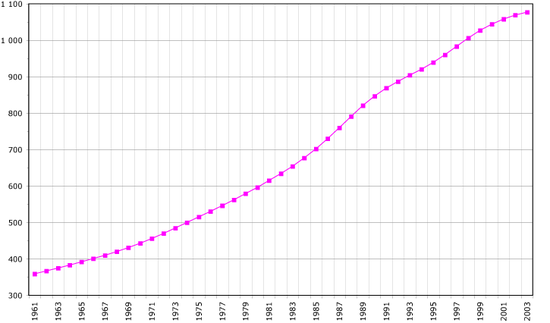Demographics of Swaziland
2007 Schools Wikipedia Selection. Related subjects: African Geography
The majority of Swaziland's population is ethnic Swazi, mixed with a small number of Zulus and non-Africans, mostly whites of British and Afrikaner descent. Traditionally Swazis have been subsistence farmers and herders, but most now work in the growing urban formal economy and in government. Some Swazis work in the mines in South Africa. Swaziland also received Portuguese settlers and black refugees from Mozambique. Christianity in Swaziland is sometimes mixed with traditional beliefs and practices. Most Swazis ascribe a special spiritual role to the monarch.
The country's official languages are Siswati (a language related to Zulu) and English. Government and commercial business is conducted mainly in English. Asians, Afrikaners, Portuguese, and black Mozambicans speak their own languages.
Population: 1,161,219 (July, 2003 est.), 1,083,289 (July, 2000 est.)
note: Estimates for this country explicitly take into account the effects of excess mortality due to AIDS; this can result in lower life expectancy, higher infant mortality and death rates, lower population and growth rates, and changes in the distribution of population by age and sex than would otherwise be expected.
Age structure:
0-14 years: 41.4% (male 242,762; female 238,141) (2003 est.), 46% (male 245,626; female 247,825) (2000 est.)
15-64 years: 55.1% (male 317,526; female 321,709) (2003 est.), 52% (male 270,308; female 291,884) (2000 est.)
65 years and over: 3.5% (male 18,040; female 23,041) (2003 est.), 2% (male 11,357; female 16,289) (2000 est.)
Median age:
total: 18.5 years
male: 18.2 years
female: 18.8 years (2002)
Population growth rate: 0.83% (2003 est.), 2.02% (2000 est.)
Birth rate: 29.37 births/1,000 population (2003 est.), 40.64 births/1,000 population (2000 est.)
Death rate: 21.08 deaths/1,000 population (2003 est.), 20.4 deaths/1,000 population (2000 est.)
Net migration rate: 0 migrant(s)/1,000 population (2000 est.)
Sex ratio:
at birth: 1.02 male(s)/female (2003 est.), 1.03 male(s)/female (2000 est.)
under 15 years: 0.99 male(s)/female (2003, 2000 est.)
15-64 years: 0.99 (2003 est.), 0.93 male(s)/female (2000 est.)
65 years and over: 0.78 (2003 est.), 0.7 male(s)/female (2000 est.)
total population: 0.99 (2003 est.), 0.95 male(s)/female (2000 est.)
Infant mortality rate:
total: 67.44 deaths/1,000 live births (2003 est.), 108.95 deaths/1,000 live births (2000 est.)
female: 63.99 deaths/1,000 live births (2003 est.)
male: 70.79 deaths/1,000 live births (2003 est.)
total population: 39.47 years male: 41.02 years female: 37.87 years (2003 est.)
Life expectancy at birth:
total population: 33.22 (2005 est.), 39.47 (2003 est.),
male: 32.49 (2005 est.), 39.54 years (2000 est.)
female: 33.98 (2005 est.), 37.87 (2003 est.)
Total fertility rate: 3.92 children born/woman (2003 est.), 5.87 children born/woman (2000 est.)
HIV/AIDS - adult prevalence rate:: 33.4% (2001 est.)
HIV/AIDS - people living with HIV/AIDS:: 170,000 (2001 est.)
HIV/AIDS - deaths:: 12,000 (2001 est.)
Nationality:
noun: Swazi(s)
adjective: Swazi
Ethnic groups: African 97%, European 3%
Religions: Christianity 57%, Zionist (a blend of Christianity and indigenous ancestral worship) 40%, other faiths ( Muslim, Bahá'í) 3%
Languages: English (official, government business conducted in English), siSwati (official)
Literacy:
definition: age 15 and over can read and write
total population: 81.6% (2003 est.), 76.7% (1995 est.)
male: 82.6% (2003 est.), 78% (1995 est.)
female: 80.8% (2003 est.), 75.6% (1995 est.)
Algeria • Angola • Benin • Botswana • Burkina Faso • Burundi • Cameroon • Cape Verde • Central African Republic • Chad • Comoros • Democratic Republic of the Congo • Republic of the Congo • Côte d'Ivoire (Ivory Coast) • Djibouti • Egypt • Equatorial Guinea • Eritrea • Ethiopia • Gabon • The Gambia • Ghana • Guinea • Guinea-Bissau • Kenya • Lesotho • Liberia • Libya • Madagascar • Malawi • Mali • Mauritania • Mauritius • Morocco • Mozambique • Namibia • Niger • Nigeria • Rwanda • São Tomé and Príncipe • Senegal • Seychelles • Sierra Leone • Somalia • South Africa • Sudan • Swaziland • Tanzania • Togo • Tunisia • Uganda • Western Sahara (Sahrawi Arab Democratic Republic) • Zambia • Zimbabwe
Dependencies and other territories
British Indian Ocean Territory • Canary Islands • Ceuta • Melilla • Madeira Islands • Mayotte • Réunion • St. Helena
